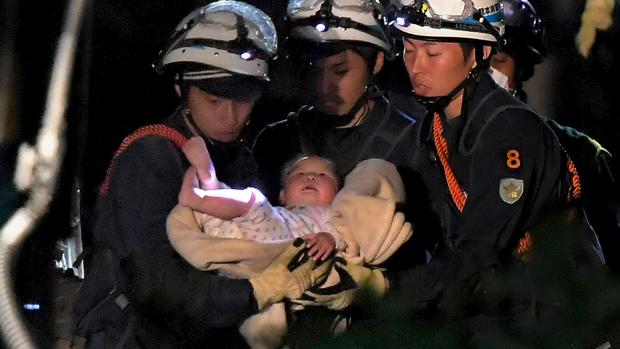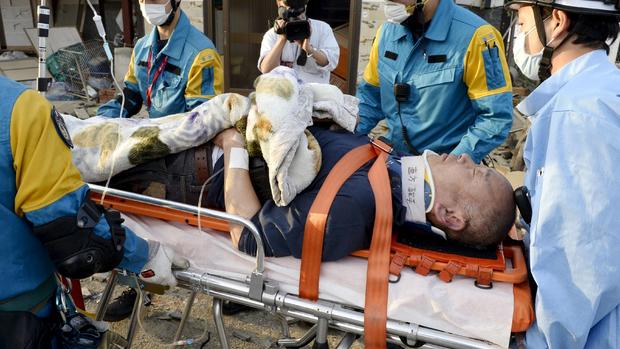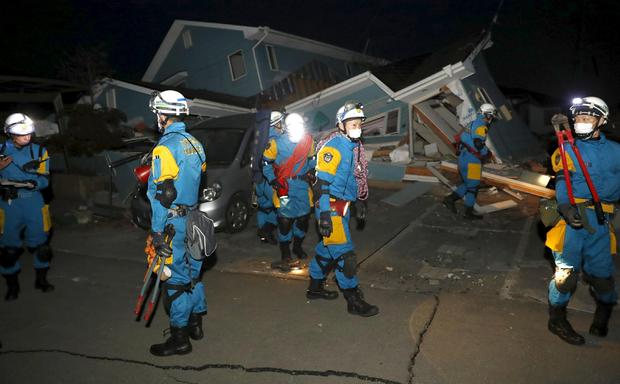Death toll rises from powerful quakes in southern Japan
MASHIKI, Japan --Two powerful earthquakes a day apart shook southwestern Japan, killing at least 29 people, injuring 1,500, trapping many beneath flattened homes and sending thousands to seek shelter in gymnasiums and hotel lobbies.
The exact number of casualties remained unclear as rescue efforts continued to unfold Saturday. Oncoming rains could further complicate the relief operation and set off more mudslides in isolated rural towns, where people were waiting to be rescued in collapsed homes.
Kumamoto Prefectural official Tomoyuki Tanaka said the death toll was climbing by the hour, with the latest standing at 19 from Saturday's magnitude-7.3 quake that shook the Kumamoto region on the southwestern island of Kyushu at 1:25 a.m. On Thursday night, Kyushu was hit by a magnitude-6.5 quake that left 10 dead.
Chief Cabinet Secretary Yoshihide Suga said that 1,500 people have been injured, 80 of them seriously. Nearly 70,000 have left their homes, he said.
A series of aftershocks ensued, including a magnitude-5.4 Saturday morning. The Japan Meteorological Agency said that the quake that struck earlier Saturday may be the main quake, with the earlier one a precursor.
The quakes' epicenters have been relatively shallow -- about six miles -- and close to the surface, resulting in more severe shaking and damage. NHK TV said as many as eight quakes were being felt an hour in the area.
Cal Tech seismologist Dr. Lucy Jones said Thursday's smaller quake was actually what's known as a "foreshock," because it triggered the bigger one about eight miles away.
"About five to 10 percent of the time, the earthquake that's triggered gets bigger than the first one and then we change the name and call the first one the foreshock and the other the main shock," Jones told CBS News.
"It's always possible for every earthquake that it will trigger something larger," she said. "The space and time we are currently in is the most dangerous in that particular region."
Jones said there was still a 50 percent chance of at least a magnitude 6 hitting the same area of Japan in the next few days.
Once three days have passed, the odds of a stronger quake drops by 95 percent, according to Jones.
Japanese media reported that nearly 200,000 homes were without electricity. Drinking water systems had also failed in the area. TV footage showed people huddled in blankets, quietly, shoulder to shoulder, on floors of evacuation centers.
Suga told reporters the number of troops in the area was being raised to 20,000 for rescue efforts, while additional police and firefighters were also on the way. He held back on giving a death tally, warning that such numbers may grow.
He pleaded with people not to panic. "Please let's help each other and stay calm," he said in a nationally televised news conference.
Mount Aso, the largest active volcano in Japan which is located on Kyushu, erupted for the first time in a month, sending smoke rising about 328 feet into the air, but no damage was reported. It was not immediately clear if there's a link the seismic activity and the eruption. The 5,223 foot high mountain is about 1 ½ hour drive from the epicenter.
The Nuclear Regulation Authority reported no abnormalities at Kyushu's Sendai nuclear plant.
NHK TV showed stones tumbled from the walls of historic Kumamoto Castle, and a wooden structure in the complex was smashed. At the Ark Hotel, east of the castle, hotel guests woke up to strong shaking and a warning siren. Hotel staff told guests, including tourists and journalists covering the quake, to evacuate their rooms and gather in the lobby for safety.
A bright spot, broadcast repeatedly on television Friday, was the overnight rescue of an apparently uninjured baby, wrapped in a blanket and carried out of the rubble of a home.
Saturday's quake hit residents who were still in shock from the previous night's earthquake and had suffered through more than 100 aftershocks.
Yuichiro Yoshikado said Thursday's quake stuck as he was taking a bath in his apartment in Mashiki.
"I grabbed onto the sides of the bathtub, but the water in the tub, it was about 70 percent filled with water, was going like this," he said, waving his arms, "and all the water splashed out."
Yoshikado, whose building was undamaged despite the intense shaking, checked the damage at his aunt and uncle's home nearby. Kitchenware was scattered on the floor, and a clock had stopped around 9:26 p.m., the time of Thursday's quake.
"I thought I was going to die and I couldn't bear it any longer," he said.




